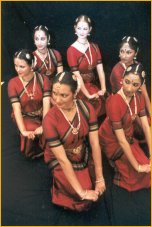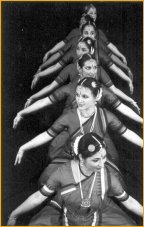 |
 |
RANGOLI FESTIVAL OF MUSIC AND DANCE - IYENGAR’S SUMPTUOUS VISION by Prem Kishore and Anuradha Kishore Ganpati, Los Angeles e-mail:Premulu@aol.com December 2002 |
 |
 |
| The
unique and innovative World Festival of Sacred Music in Los Angeles encompassing
varied traditions and sounds of faith drew thousands of artists, presenters,
religious and civic leaders. They came bringing integrity of music, dance,
breaking down narrow identities and invoking peace and harmony.
Among the fifty three events of music and dance across Los Angeles, Rangoli Foundation for Art & Culture (established in 1985 by choreographer/dancer Malathi Iyengar) and South Asia Club, California State University, Northridge, presented a two day festival, Sept 27 and 28, 2002 at the New Performing Arts Center, California State University, Northridge, featuring dancers of all ages, showcasing their immense artistic potential reflecting the multicultural population of Los Angeles. Sacred Geometry (concept and choreography Malathi Iyengar), explored the geometric figures and shapes describing the beauty of creation in Hindu thought. Iyengar is marvelous in her ability to masterfully envision through movement, space and music, the ritual, theological and cosmological significance of the geometric truism of variant forms. Elegantly representing circles, squares, or triangles that can be enlarged or repeated so that all points of energy are regarded by the womb-the center from which all originate, Iyengar’s choreography is an expression of unity, completeness and integrity-movement, music and space echo total inclusion, no one form is greater or lesser. Iyengar’s choreography was inspiring, enhancing not only the story telling aspect of dance but revealing a passion and artistry based on ancient connections. As Iyengar says “Classical dances of India depict geometric angular relationships from the axis of the body’s center of gravity. These positions, while defining principle angles, are also often attributed to various deities and are meant to convey their characteristic powers. Whether the product of an eastern or western culture, these pervasive images are found throughout history of visual and performing arts.” Iyengar’s Navagraha, (the nine planets), is both an act of worship as well as a deeply crystallized and stunningly crafted artistic endeavor. Expressed as spiritual art, Iyengar created concepts and forms to represent the movement of these nine bodies that are divinely and inextricably connected to creation of life on earth. This was followed by the Thillana. A pleasant surprise was the riotous folk expressions (choreographed by K Murali Mohan). Performers: Ronald Burton, Sandra Chatterjee, K Murali Mohan, Shyamala Moorthy, Lakshmi Iyengar, Renjith Babu, Neewin Hershall, Alia Rice, Shaheen Sheik, Padmini Sirish, Soumya Sundaresh. Guest choreographers Gary Larsen-with a quirky droll clogging, Linda Gold performing “Sanctuary” to the background of chants and polyphony from Medieval England, Kathak techniques-Jahapp Taal with K Murali Mohan. The evening ended with an exuberant performance by Ballet Kouman Kele West African Dance and Drum ensemble choreographed with great vivacity by Nzingha Camara. On Saturday,
Iyengar presented, Aarohi - Avarohi a music ensemble featuring Latha Ramchand,
Sowmya Kumar (vocals), Shankar Subbramanian (violin), HS Venugopal (flute)
and G Gurumurthy (mridangam). Dancers Like Me, featured second generation
Indian American and Americans performers which included disciples of Iyengar
and Guru Narmada. Bharatanatyam dancer, Alia Rice began the program with
the Pushpanjali, an offering of flowers to honor the mother earth, gods,
teachers and the audience. The engaging Lakshmi Iyengar and Padmini Sirish
performed Sri Chakra, a dance in praise of mother goddess Devi, followed
by Devaranama a devotional song extolling the glory of Krishna
interpreted by Shivani Aysola in dance. Shaheen Sheik presented Tani Avarthanam,
focusing on rhythmic circles and multiple calculations, in collaboration
with the percussionist.
The evening concluded with Anjali Tata, Stephanie Adcock and Hyun Jung Kim in a specially choreographed piece by Anjali Tata, Empty Prayers where three women seek connections between the physical and psycho -spiritual aspects of their yoga practice. Shaheen and
Kyan (vocals and guitar) presented an original piece on unconditional love
while Sandra Chatterjee and Shymala Moorthy challenged racial differences
and celebrated new and unexpected cultures in 2 ‘in” 1. Shymala Moorthy
then presented another piece Balance Of Being referring to the East/West
duality by dividing her body down the center as she practised ballet on
one side of her body and Bharatha Natyam on the other. The evening ended
with choreography and performance Hapa by Sandra Chatterjee, embodying
her experience of getting to know the Hapa way while living in Hawaii.
|